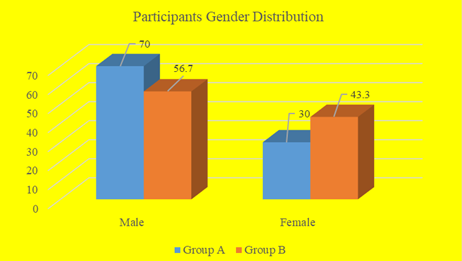Magnesium sulfate versus fentanyl as an adjuvant with bupivacaine in supraclavicular brachial plexus block- A comparative study
Abstract
Background: Brachial plexus block is an excellent method for attaining optimal operating conditions for upper limb surgeries. This method produces complete muscular relaxation, maintaining hemodynamic stability. Objectives: The objective of the study was to evaluate the effectiveness of magnesium sulfate and fentanyl as an adjuvant to bupivacaine in supraclavicular brachial plexus block. Methods: This observational study was conducted in the Department of Anaesthesiology and ICU, Bangladesh Medical College Hospital over a period of six months after acceptance of protocol. Study populations were patients of ASA Status I–II planned for upper limb orthopedic surgical procedures under supraclavicular brachial plexus block. Study populations were randomly allocated into one of the two groups, 30 in each- group A & B. Group A - Patients received 38 ml of 0.25% bupivacaine with 100 μg (2ml) of fentanyl to make a total volume of 40 ml. Group B - Patients given 38 ml of 0.25% bupivacaine with 80mg (2ml, 4%) magnesium sulfate. Parameters observed were demographic, hemodynamics, onset, and duration of sensory and motor block, analgesia. By using SPSS, version 22.0 data were analyzed. A Chi-square test was applied for qualitative data and an Unpaired t-test was applied for quantitative data. the p-value of <0.05 was considered statistically significant. Results: In this study, there was no significant difference between groups in respect of demographic (age, gender) and ASA status (p>0.05). Regarding hemodynamics (heart rate, systolic blood pressure, diastolic blood pressure, mean arterial pressure) were no statistically significant differences between Group A and Group B (p>0.05). The onset of sensory (p=0.825) and motor block (p=0.968) was not statistically significant between the two groups. Duration of sensory and motor block was significantly increased in Group A compared to Group B (p=0.001). Duration of analgesia was no significant difference between the two groups (p=0.127). No significant difference in the total number of rescue analgesics between Group A and Group B (p=0.640). From this study, it is found that magnesium sulfate, as well as fentanyl as an adjuvant to bupivacaine, prolongs the duration of sensory and motor block in supraclavicular brachial plexus block. Conclusion: Magnesium sulfate, as well as fentanyl as an adjuvant to bupivacaine, prolongs supraclavicular brachial plexus block.
Downloads
References
Neal JM, Gerancher JC, Hebl JR, Ilfeld BM, McCartney CJ, Franco CD, Hogan QH. Upper extremity regional anesthesia: essentials of our current understanding, 2008. Regional Anesthesia & Pain Medicine. 2009 Feb 1;34(2):134-70.
Kothari D. Supraclavicular brachial plexus block: A new approach. Indian journal of anaesthesia. 2003 Jul 1;47(4):287.
Kusre S, McEwen A, Matthew G. Ultrasound-Guided Supraclavicular Brachial Plexus Block. ATOTW, 2018; 1-8.
Yang CM, Kwon HU, Cho CK. A comparison of infraclavicular and supraclavicular approaches to the brachial plexus using neurostimulation. Korean J Anesthesiol.2010; 58(3): 260-266.
Buttner J. Axillary and mid humeral approach for Brachial Plexus Block. Curr Opin Anaesthesiol, 1998; 11: 499-502.
Farooq N, Singh RB, Sarkar A, Rasheed M and Choubey S. To Evaluate the Efficacy of Fentanyl and Dexmedetomidine as Adjuvant to Ropivacaine in Brachial Plexus Block: A Double-blind, Prospective, Randomized Study. Anesth Essays Res. 2017; 11(3): 730-739.
Mukherjee K, Das A, Basunia S, Dutta S. Evaluation of Magnesium as an adjuvant in Ropivacaine-induced supraclavicular brachial plexus block: A prospective, double-blinded randomized controlled study. J Res Pharm Pract. 2014; 3(4): 123-129.
Sayed MB, Mostafa Abd El-Hameed S, Mohammed Yousef Ahmed E. comparative study between dexamethasone and fentanyl as an adjuvant to bupivacaine in ultrasound guided supraclavicular brachial plexus block in upper limb surgeries. Al-Azhar Medical Journal. 2019 Oct 1;48(4):501-12.
Nath MP, Garg R, Talukdar T, Choudhary D, Chakrabarty A. To evaluate the efficacy of intrathecal magnesium sulphate for hysterectomy under subarachnoid block with bupivacaine and fentanyl: A prospective randomized double blind clinical trial. Saudi journal of anaesthesia. 2012 Jul;6(3):254.
Khezri MB, Yaghobi S, Hajikhani M, Asefzadeh S. Comparison of postoperative analgesic effect of intrathecal magnesium and fentanyl added to bupivacaine in patients undergoing lower limb orthopedic surgery. Acta Anaesthesiologica Taiwanica. 2012 Mar 1;50(1):19-24.
Malleeswaran S, Panda N, Mathew P, Bagga R. A randomised study of magnesium sulphate as an adjuvant to intrathecal bupivacaine in patients with mild preeclampsia undergoing caesarean section. International journal of obstetric anesthesia. 2010 Apr 1;19(2):161-6.
Ramos-Matos C and Lopez-Ojeda W. Fentanyl. National Library of Medicine, National Institutes of Health. Downloaded from: https://www.ncbi.nlm.nih.gov/books/. Retrieved on January 2018.
Hamed MA, Ghaber S, Reda A. Dexmedetomidine and Fentanyl as an Adjunct to Bupivacaine 0.5% in Supraclavicular Nerve Block: A Randomized Controlled Study. Anesth Essays Res. 2018;12(2):475-479. doi:10.4103/aerate
Madhusudhana R, Kumar K, Kumar R, Potli S, Karthik D, Kapil M. Supraclavicular brachial plexus block with 0.75% ropivacaine and with additives tramadol, fentanyl-a comparative pilot study. Int J Biol Med Res. 2011;2(4):1061-3.
Rajkhowa T, Das N, Parua S, Kundu R. Fentanyl as an adjuvant for brachial plexus block: A randomized comparative study. Int J Clin Trials. 2016 Apr;3(2):64-7.
Rao L, Jeyalakshmi V, Nagaraju M, Anitha S. The effect of magnesium sulfate as an adjuvant to 0.5% bupivacaine on motor and sensory supraclavicular brachial plexus blockade. International Journal of Basic & Clinical Pharmacology | March-April 2015; 4(2): 317-20.



























